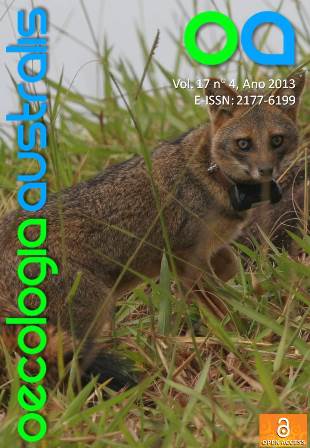HOW ARE NATIVE VEGETATION AND RESERVES AFFECTED BY DIFFERENT ROAD TYPES IN A SOUTHEASTERN BRAZILIAN STATE?
Keywords:
conservation, reserve design, road ecology, road-effect zone, tropical landscapeAbstract
Reducing connectivity, road networks may threaten the effectiveness of natural reserves, thus, representing acritical conservation matter. This work aims to: 1) evaluate the relationship between native vegetation cover and roaddistance; 2) evaluate the extent to which native vegetation and nature reserves are affected by roads. Our study area wasa neotropical landscape in the state of São Paulo, Brazil. We divided the study area into 15 subregions to represent itshigh heterogeneity. First, we demarcated buffer zones of 10 different distances around each road, and quantified thedensity of roads and native vegetation cover. Second, we estimated the area ecologically affected by roads, the roadeffect zone, using buffers of increasing distances according to each road type. The most dense road network was foundin the São Paulo Metropolitan area and the lowest was the Southern Coastline subregion, but this subregion showed thesecond highest expressway density. These two subregions had stronger positive relationships between native vegetationcover and road distance. Almost 10% of São Paulo state, about 6% of the remaining native vegetation, and more than10% of the reserves were ecologically affected by roads. More than 50% of reserves were ecologically affected, andsome have more than 60% of their territory affected. Threats related to proximity of roads, i.e. logging, may reduceeffectiveness of more than 50% of natural reserves. Thus, we propose that identifying priority areas for integral conservationof pristine environments should include mostly remote areas, which are far from larger roads and under lower generalroad influence.Downloads
Additional Files
- camiladebarros, Freitas et al_estradasSP_OA_submission letter.pdf (Português (Brasil))
- camiladebarros, Figura 1.tif (Português (Brasil))
- camiladebarros, Figura 2.tif (Português (Brasil))
- camiladebarros, Figura 3.tif (Português (Brasil))
- camiladebarros, Figura 4.tif (Português (Brasil))
- camiladebarros, Figura 5.tif (Português (Brasil))
- camiladebarros, Figura 6.tif (Português (Brasil))
- camiladebarros, Figura 7.tif (Português (Brasil))
- camiladebarros, Figura 8.tif (Português (Brasil))
- camiladebarros, Figura 9.tif (Português (Brasil))
Published
2017-02-22
Issue
Section
Articles


